All posts by Andrea Grant
About Andrea Grant
Andrea Grant is a Children's Services Specialist. View all posts by Andrea Grant →
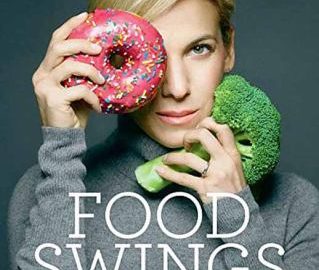
Bibliobites in September: Virtue, Vice, and Everything Nice
 With so much conflicting information out there about the best or healthiest way to eat, what’s your average person to do? Do we come down firmly on the side of “virtue,” focusing on protein, veggies, and modest amounts of “good” fats? Or do we succumb to “vice,” and hunker down with lots of sugars, carbs, and the tempting trifecta of butter, cheese, and full-fat dairy? Jessica Seinfeld’s newest book, Food Swings: 125+ recipes to enjoy your life of virtue and vice, aims to find a middle ground where we can enjoy eating — well, pretty much anything!
With so much conflicting information out there about the best or healthiest way to eat, what’s your average person to do? Do we come down firmly on the side of “virtue,” focusing on protein, veggies, and modest amounts of “good” fats? Or do we succumb to “vice,” and hunker down with lots of sugars, carbs, and the tempting trifecta of butter, cheese, and full-fat dairy? Jessica Seinfeld’s newest book, Food Swings: 125+ recipes to enjoy your life of virtue and vice, aims to find a middle ground where we can enjoy eating — well, pretty much anything!
As you might guess, the book is organized into two halves: the first, dubbed “virtue” contains recipes that showcase ample quantities of vegetables, whole grains, and lean proteins. Conversely, the “vice” half cuts loose a bit, with recipes featuring plenty of cheese, red meat, and calorie-dense desserts. In either half of the book, we found that most of the recipes were relatively simple and easy to follow, and many fit on one page. The large format was attractive, and photos were numerous and visually appealing. And thanks to its larger size, the book stayed open when we wanted it to. One common complaint was that the time listed to make the recipe was noticeably inaccurate– it took most of us way longer than the author stated. We ultimately decided that the time listed referred to time spent actually cooking, after all ingredient-locating and prepping was complete. But once all the chopping and cooking was done, did we enjoy the results?
On the “virtue” side, there were some definite winners. Four people made roasted spaghetti squash with almonds, cinnamon, and sage— and everyone thought this was a fantastic combination of flavors. In particular, we liked the fresh sage. One drawback– the thick-skinned squash is tricky to cut in half when raw; caution must be exercised to avoid injury! Moroccan chicken also featured a nice combination of spices and was easy to put together. We also liked  cod with garlicky tomatoes and potatoes which was a simple yet tasty one-pot meal. Another good weeknight choice was tangy and spicy chicken and peppers, a colorful dish that came together quickly. Quinoa chili was “much better than I thought it would be,” really delicious and probably a keeper! Quinoa also made an appearance in the quinoa banana-date muffins, which were a tender yet hearty breakfast muffin, pleasantly sweet without any added sugar. One caveat: they contain mostly almond flour, which is an expensive ingredient And roasted plums with honey and pistachios turned out to be the simplest, most amazingly yummy dessert– roasting the fruit brought out its sweet-tart flavor, and the pistachio and mint garnish put it all over the top.
cod with garlicky tomatoes and potatoes which was a simple yet tasty one-pot meal. Another good weeknight choice was tangy and spicy chicken and peppers, a colorful dish that came together quickly. Quinoa chili was “much better than I thought it would be,” really delicious and probably a keeper! Quinoa also made an appearance in the quinoa banana-date muffins, which were a tender yet hearty breakfast muffin, pleasantly sweet without any added sugar. One caveat: they contain mostly almond flour, which is an expensive ingredient And roasted plums with honey and pistachios turned out to be the simplest, most amazingly yummy dessert– roasting the fruit brought out its sweet-tart flavor, and the pistachio and mint garnish put it all over the top.
There were some misses in this half of the book as well. Vegetable soup was “a definite no,” as its flavor was anemic– probably because its base was water, not broth. Roasted carrots and chickpeas with feta vinaigrette was initially pretty appealing (and the crispy chickpeas by themselves were excellent), but unfortunately it wasn’t good when reheated. Baked vegetable chips were hard to get right– the potato peeler recommended to make the chips made slices that were too thin, and using a mandoline seemed to make them too thick! Two people tried the ginger salmon with sesame cucumbers and thought it was just OK– no one liked the cucumbers; and the dish needed more accompaniments to make it a meal (how about the spaghetti squash above??). Farro bowl with shaved broccoli and Parmesan was loaded with obviously healthy ingredients, but it wasn’t that enjoyable to eat; the taste was “meh!”  Lemon-thyme milk-braised chicken with spinach was similarly noticeably virtuous; but though the milk-braising idea was intriguing, overall it was a fairly boring dish. And (as the photo shows), the milk sauce curdled and separated despite careful adherence to the recipe, which made a visually unappealing mess. Lastly, coconut milk panna cotta was a disappointment– it was very plain, and even if it was on the “virtue” side, it definitely needed more sugar– or something!
Lemon-thyme milk-braised chicken with spinach was similarly noticeably virtuous; but though the milk-braising idea was intriguing, overall it was a fairly boring dish. And (as the photo shows), the milk sauce curdled and separated despite careful adherence to the recipe, which made a visually unappealing mess. Lastly, coconut milk panna cotta was a disappointment– it was very plain, and even if it was on the “virtue” side, it definitely needed more sugar– or something!
So we certainly gave virtue a fair try; what about vice? Many of the main dish recipes on this side of the book could be defined as comfort food– for instance, a few people tried red wine and shallot beef stew. The recipe featured a rich wine sauce with chunky vegetables; it reheated well, as many stews do. One person felt this recipe was nothing special, but others thought it was a very good version of this classic dish. There were some other classic dishes in this section that we enjoyed: the lasagne bolognese was “really delicious– meaty and creamy;” corn chowder with bacon was extra-good with its crunchy-fresh off-the-cob sweet corn; shrimp scampi had a tasty, hearty sauce; and pulled bbq chicken sandwiches with coleslaw had a fantastic classic sauce, and the coleslaw was excellent as well. Blue cheese burgers weren’t anything innovative; but were definitely enjoyable, since how can you go wrong with a burger and blue cheese? 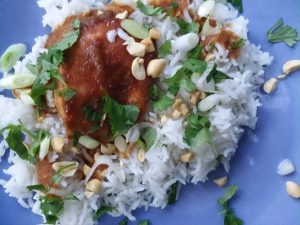 Peach and sriracha chicken over coconut rice was a winner– nicely spiced chicken and rich-tasting rice. Its garnish of scallions, peanuts, and cilantro made the dish look beautiful, and enhanced its flavors as well. Spicy eggplant pasta also had a bit of heat, though not all that much– just a bit of red pepper flakes. The roasted vegetables in this dish were first-rate all by themselves, but the completed dish was “good, not great.” Pine nut and parsley pasta was similarly good, but “kind of ordinary.” On the other hand, creamy mushroom pasta was super-creamy and smooth, with plenty of mushrooms– just a wonderful combination. Crispy fish with tartar sauce was crunchy and tasty; it was a standard version of this classic that most of us always enjoy. With your fish you might like skillet-roasted potatoes and tomatoes, which was a fine combination of the two main ingredients. In the dessert section, two people made one-pot mocha brownies. While they were perfectly fudgy and chocolatey, neither cook thought they were better than their usual recipe. And apple galette showcased a nicely flaky crust with a complementary tart Granny Smith filling.
Peach and sriracha chicken over coconut rice was a winner– nicely spiced chicken and rich-tasting rice. Its garnish of scallions, peanuts, and cilantro made the dish look beautiful, and enhanced its flavors as well. Spicy eggplant pasta also had a bit of heat, though not all that much– just a bit of red pepper flakes. The roasted vegetables in this dish were first-rate all by themselves, but the completed dish was “good, not great.” Pine nut and parsley pasta was similarly good, but “kind of ordinary.” On the other hand, creamy mushroom pasta was super-creamy and smooth, with plenty of mushrooms– just a wonderful combination. Crispy fish with tartar sauce was crunchy and tasty; it was a standard version of this classic that most of us always enjoy. With your fish you might like skillet-roasted potatoes and tomatoes, which was a fine combination of the two main ingredients. In the dessert section, two people made one-pot mocha brownies. While they were perfectly fudgy and chocolatey, neither cook thought they were better than their usual recipe. And apple galette showcased a nicely flaky crust with a complementary tart Granny Smith filling.
Overall, though most in the group enjoyed at least a few recipes from this book, no one felt that it offered anything groundbreaking. The idea of sometimes eating super-healthily and other times more indulgently isn’t a foreign concept for most people– so do we need a cookbook to validate that idea? It also seemed that some of the recipes from one category could have arguably been in the other– perhaps another indication that “healthy” is a more fluid concept than is generally acknowledged. People did enjoy the simplicity and ease of preparation of most of the recipes, and there were some definite standouts. Those who liked this title really liked it; but some were ambivalent– and thus our voting averaged out to a 3.5 (out of a possible 5).
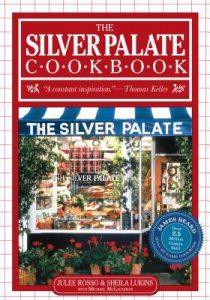 We’ll next meet on Friday, October 26 at 11 AM in the Fireplace Room. We’ll be exploring an ’80s classic this month: The Silver Palate Cookbook by Julee Rosso and Sheila Lukins. Copies are available at the main desk. All are welcome, hope to see you there!
We’ll next meet on Friday, October 26 at 11 AM in the Fireplace Room. We’ll be exploring an ’80s classic this month: The Silver Palate Cookbook by Julee Rosso and Sheila Lukins. Copies are available at the main desk. All are welcome, hope to see you there!
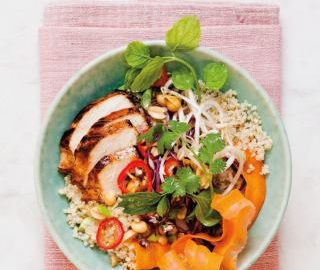
Bibliobites in June: Belatedly Bowling
September is here, which means that soon our Bibliobites group will again be reading, cooking, and reporting back on their culinary adventures. Some of you may have noticed the lack of a review about our June meeting; and much as I’d like to blame my omission on an extended vacation to an exotic location, I’m afraid I don’t have such an enticing excuse—but let’s just pick up where we left off…….
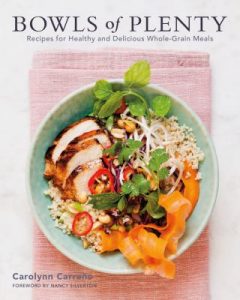 Grain bowls, it seems, are everywhere these days. You can find them in small cafes, breakfast diners, fast food outlets, coffee shops, and fancy bistros. They are ubiquitous for some of the same reasons that their cousin, the salad bar, is so popular: you can mix and match a wide range of fresh ingredients to suit yourself, and assemble a complete meal in one tidy package—or bowl, as it were! And our June title, Bowls of Plenty by Carolynn Carreno, aims to show us how simple it is to make a wide range of bowls at home for breakfast, lunch, dinner, or dessert. But were we bowled over by the possibilities, or did Ms. Carreno roll us a gutter ball?
Grain bowls, it seems, are everywhere these days. You can find them in small cafes, breakfast diners, fast food outlets, coffee shops, and fancy bistros. They are ubiquitous for some of the same reasons that their cousin, the salad bar, is so popular: you can mix and match a wide range of fresh ingredients to suit yourself, and assemble a complete meal in one tidy package—or bowl, as it were! And our June title, Bowls of Plenty by Carolynn Carreno, aims to show us how simple it is to make a wide range of bowls at home for breakfast, lunch, dinner, or dessert. But were we bowled over by the possibilities, or did Ms. Carreno roll us a gutter ball?
The book itself generated one universal complaint: the print is tiny! I could just envision everyone at home, squinting over the page (as I was) as they tried to decipher an ingredient list. To add insult to injury, the type isn’t a crisp black; it’s a soft gray that further reduces readability. On the plus side, the teensy type meant that many of the recipes fit on one page. The numerous photographs depicted the bowls artistically, beautifully displaying a recipe’s multiple components. And the book was a nice size, big enough to stay open easily, but small enough to hold comfortably.
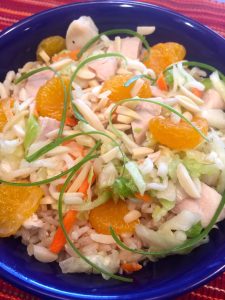 Once we were actually able to read the recipes, there were some definite hits. The Baja bbq shrimp bowl with corn rice was quite tasty; the sauce for the shrimp was especially good. Warm chicken Caesar bowl featured quinoa for its grain base, which combined well with the marinated chicken. Three people tried Chinese chicken salad, and all thought the directions to toast the bowl’s cooked rice until crispy just didn’t work. It didn’t improve the taste or texture of the finished dish. Otherwise this was a refreshing melange of ingredients; but just use regular cooked rice!
Once we were actually able to read the recipes, there were some definite hits. The Baja bbq shrimp bowl with corn rice was quite tasty; the sauce for the shrimp was especially good. Warm chicken Caesar bowl featured quinoa for its grain base, which combined well with the marinated chicken. Three people tried Chinese chicken salad, and all thought the directions to toast the bowl’s cooked rice until crispy just didn’t work. It didn’t improve the taste or texture of the finished dish. Otherwise this was a refreshing melange of ingredients; but just use regular cooked rice! 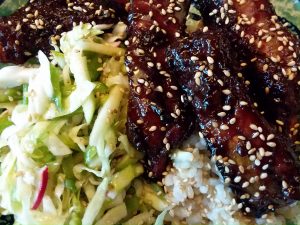 Five spice riblets with sticky rice and apple slaw was excellent; the ingredients played well together and the whole thing was fairly simple to make.
Five spice riblets with sticky rice and apple slaw was excellent; the ingredients played well together and the whole thing was fairly simple to make.
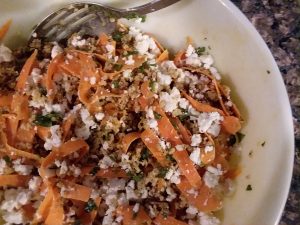 Rainbow carrot salad with millet was a hit and a miss—the millet was a bit fussy to cook, though the overall combination was colorful and enjoyable. And spiced rice and lentils with seared halloumi suffered from “bland” rice and lentils, though the halloumi was good, if a bit salty. The baba ganoush served with it was a delectable version of this well-known side dish. The farmers’ market bowl, despite its pleasant assortment of veggies, was kind of boring, though its accompanying green goddess dressing was first-rate and could easily be put to many uses.
Rainbow carrot salad with millet was a hit and a miss—the millet was a bit fussy to cook, though the overall combination was colorful and enjoyable. And spiced rice and lentils with seared halloumi suffered from “bland” rice and lentils, though the halloumi was good, if a bit salty. The baba ganoush served with it was a delectable version of this well-known side dish. The farmers’ market bowl, despite its pleasant assortment of veggies, was kind of boring, though its accompanying green goddess dressing was first-rate and could easily be put to many uses.
There were some definite opinions about this title, and grain bowls in general. It can be time-consuming to prep vegetables and/or protein, to make sauce, cook whole grains, etc. Once you have several components ready in your fridge, you’re golden—you have the makings for multiple quick meals. In fact some do this already with leftovers, assembling a meal from bits and pieces hanging around in the fridge. But to make a bowl from scratch, all in one go, means spending some quality time in the kitchen. Perhaps this is why bowls are so popular in restaurants—you can pick and choose without having to do it all yourself. Bowls can therefore also be a good choice for a party or a family—everyone chooses the parts they like best, and hopefully everyone helps with prep. Another consideration (I’m talking to you, Mr. Fussy) is that some people don’t like foods all mixed together, which is pretty much what bowls are all about. So while most said they enjoyed this style of eating and understood why it was popular, not too many wanted to “go bowling” at home.
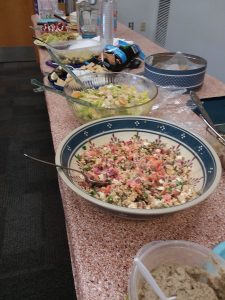 We ended our meeting with a potluck lunch, where we enjoyed so many delicious dishes, including some of the recipes mentioned above. Thank you to all for your efforts, and for your participation over the past year. I look forward to seeing everyone on Friday, September 28 at 11 AM in the Fireplace Room, when we’ll be discussing Jessica Seinfeld’s Food swings: 125 recipes to enjoy your life of virtue and vice. Copies are available at the main desk.
We ended our meeting with a potluck lunch, where we enjoyed so many delicious dishes, including some of the recipes mentioned above. Thank you to all for your efforts, and for your participation over the past year. I look forward to seeing everyone on Friday, September 28 at 11 AM in the Fireplace Room, when we’ll be discussing Jessica Seinfeld’s Food swings: 125 recipes to enjoy your life of virtue and vice. Copies are available at the main desk.

Bibliobites in May: Fizzy, Fruity, and Fresh
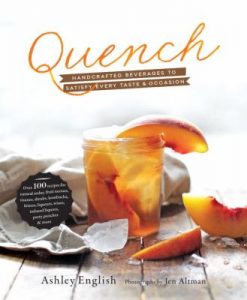 Author Ashley English is a sort of one-woman cottage industry for teaching “homesteading” skills; she’s written books on beekeeping, canning, home dairying (a past Bibliobites selection), and keeping chickens. This month’s title, Quench: Handcrafted Beverages to Satisfy Every Taste and Occasion, is in a similar vein. As in her other books, English shows us how to make something (in this case, beverages) from scratch that we would normally buy at a store. Is it worth the time and trouble to D-I-Y?
Author Ashley English is a sort of one-woman cottage industry for teaching “homesteading” skills; she’s written books on beekeeping, canning, home dairying (a past Bibliobites selection), and keeping chickens. This month’s title, Quench: Handcrafted Beverages to Satisfy Every Taste and Occasion, is in a similar vein. As in her other books, English shows us how to make something (in this case, beverages) from scratch that we would normally buy at a store. Is it worth the time and trouble to D-I-Y?
Making fizzy drinks appealed to a few people; two tried the orange soda but had contrasting opinions on the outcome. One person thought it was refreshing and not overly sweet (in a good way); but for another person it was too mild– just not orange-y enough. On the other hand, ginger brew had plenty of clean, sharp ginger flavor that would hit the spot on a hot day; and the cola was a tasty, sweet-and-spicy blend that could more than hold its own against its commercial red-canned cousin. One group member wanted to make root beer but was discouraged when she read the list of ingredients, which included such rarities as sarsaparilla root and sassafras root. Though these items might be purchased online, you’d likely have to buy a far larger quantity than you needed, and/or spend more than you’d like. The same problem surfaced with rhubarb bitters (an ingredient in strawberry fields forever, a delicious-sounding cocktail), which seemed like a fun seasonal recipe– but it called for dried dandelion root, angelica root, and hyssop. Unless you have an herb garden, or have dug up the dandelions in your yard, those ingredients would be difficult to find. Two other dried herbs that proved oddly troublesome to locate were spearmint and peppermint, called for in happy belly tea. These at least are embarrassingly easy to grow at home, if mint tea is a favorite of yours.
Other summery drinks we tried included the blueberry lemonade, which was a winner: it had plentiful blueberry flavor that played well with the tart lemon. It would be a perfect drink for a summer party: fruity, refreshing, and easy to make. Watermelon agua fresca was also quick and simple to prepare; it was “delicious!” and not too sweet, containing only one tablespoon of honey per batch.  Horchata, an iced Mexican drink made with homemade rice milk and cinnamon, was a bit on the sweet side but was quite refreshing nonetheless. Though you had to plan ahead to make this (the rice steeps in water for four hours), there were only a few simple steps overall, and the result was something distinct and tasty. We noted the absence in this book of that popular summertime New England drink, the raspberry lime rickey. This fizzy concoction is a staple on local summer restaurant menus, but it’s certainly easy to make yourself. Perhaps author English, being from North Carolina, is not familiar with this treat?
Horchata, an iced Mexican drink made with homemade rice milk and cinnamon, was a bit on the sweet side but was quite refreshing nonetheless. Though you had to plan ahead to make this (the rice steeps in water for four hours), there were only a few simple steps overall, and the result was something distinct and tasty. We noted the absence in this book of that popular summertime New England drink, the raspberry lime rickey. This fizzy concoction is a staple on local summer restaurant menus, but it’s certainly easy to make yourself. Perhaps author English, being from North Carolina, is not familiar with this treat?
This book, like most of English’s other titles, has a somewhat smaller format; but since most of the recipes are brief, almost all fit on one page. The book did have some trouble staying open, as the binding is quite tight. Even when opened to the middle pages, it would flop closed– a common, if minor, annoyance. Numerous lush, evocative photographs paint a picture of a relaxed rural lifestyle; the photos were so gorgeous that they proved a bit intimidating for some–“my life sure doesn’t look like that!” Agreed; but perhaps we can all dream a bit? And if you’re looking for new ideas on how to attractively present/serve beverages, the photos provide lots of inspiration.
Overall, the main problem with this title (as has been true with a few books this year) is that while we might appreciate the concept of making it ourselves, in actual practice we don’t want to spend the extra time (real or perceived) that it takes. For us this title kind of fell into the “hobby” category: though it won’t get dinner on the table, it’s fun to experiment with when we want to play in the kitchen. This book would be a good choice for a gardener interested in herbs or fruit; for someone who’s really into beverages as a category; or for someone who enjoys the D-I-Y aspect. Though most of us discovered at least one recipe we’d be happy to (occasionally) make again, our overall rating was a “3ish” out of a possible five. So is it worth the time and trouble to do it yourself? Our answer is a resounding “maybe….sometimes….sort of!”
 Our last meeting until September will be on Friday, June 29 at 11 AM in the McCarthy Meeting Room. June’s title is Bowls of Plenty by Carolynn Carreno; copies are available at the main desk. This meeting will feature a potluck lunch; bring an (optional) bowl or salad to share, either from the book or one of your tried-and-true favorites. All are welcome, please join us!
Our last meeting until September will be on Friday, June 29 at 11 AM in the McCarthy Meeting Room. June’s title is Bowls of Plenty by Carolynn Carreno; copies are available at the main desk. This meeting will feature a potluck lunch; bring an (optional) bowl or salad to share, either from the book or one of your tried-and-true favorites. All are welcome, please join us!
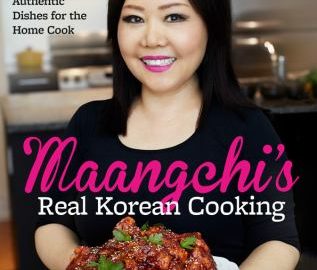
Biblioibites in April: Anyeong-haseyo* Korea!
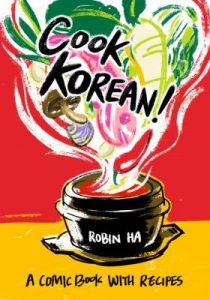 Our April meeting opened with a question: why Korea, as in what was the impetus for choosing this particular cuisine? While the short answer is, “why not,” there’s a bit more to it than that. Korean food’s profile in the US has been steadily rising over the last ten years or so; information and ingredients have become much more readily available (at least in metropolitan areas), Korean restaurants have sprouted (bean-sprouted?) up in towns both large and small, and food articles in magazines and newspapers regularly feature recipes for some of Korea’s iconic dishes, like kimchi or bibimbap. So it seems that Korean food has arrived and is poised to become as common and beloved as, say, Chinese, Thai, or Italian.
Our April meeting opened with a question: why Korea, as in what was the impetus for choosing this particular cuisine? While the short answer is, “why not,” there’s a bit more to it than that. Korean food’s profile in the US has been steadily rising over the last ten years or so; information and ingredients have become much more readily available (at least in metropolitan areas), Korean restaurants have sprouted (bean-sprouted?) up in towns both large and small, and food articles in magazines and newspapers regularly feature recipes for some of Korea’s iconic dishes, like kimchi or bibimbap. So it seems that Korean food has arrived and is poised to become as common and beloved as, say, Chinese, Thai, or Italian.
Still, it’s fair to say that most of us aren’t all that familiar with Korean food, and it can be intimidating to experiment with unknown ingredients and new flavor combinations. This month’s titles gave us plenty of advice and assistance in navigating our way through uncharted waters!
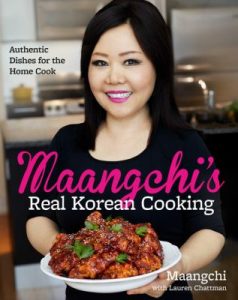 There are many websites that have information about, and recipes for, Korean food. One of the better-known ones is written by Maangchi. Her blog and videos have become so popular that she eventually wrote a cookbook, Maangchi’s Real Korean Cooking, which a few of us tried out. The book is large-format with heavy, glossy paper and plenty of photos, which are extra-helpful when you’re completely unsure what a finished dish should look like. Maangchi’s “voice” is friendly and helpful– it’s almost like having a Korean friend in your kitchen. We liked that she provides general information about the composition and presentation of a Korean meal; the book also has a nice glossary of Korean ingredients (with helpful photos of each), and a list of possible substitutions. Two additional titles we used,
There are many websites that have information about, and recipes for, Korean food. One of the better-known ones is written by Maangchi. Her blog and videos have become so popular that she eventually wrote a cookbook, Maangchi’s Real Korean Cooking, which a few of us tried out. The book is large-format with heavy, glossy paper and plenty of photos, which are extra-helpful when you’re completely unsure what a finished dish should look like. Maangchi’s “voice” is friendly and helpful– it’s almost like having a Korean friend in your kitchen. We liked that she provides general information about the composition and presentation of a Korean meal; the book also has a nice glossary of Korean ingredients (with helpful photos of each), and a list of possible substitutions. Two additional titles we used, 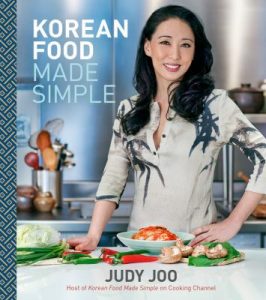 Korean Food Made Simple by Judy Joo, and The Kimchi Chronicles by Marja Vongerichten, had similar formats and equally useful ingredient glossaries. These two titles were both written in conjunction with TV shows: Joo’s book came out of a Cooking Channel show, and Vongerichten’s is a companion to a 2011 PBS series. All three titles aim (successfully) to demystify Korean cooking and make it accessible to all.
Korean Food Made Simple by Judy Joo, and The Kimchi Chronicles by Marja Vongerichten, had similar formats and equally useful ingredient glossaries. These two titles were both written in conjunction with TV shows: Joo’s book came out of a Cooking Channel show, and Vongerichten’s is a companion to a 2011 PBS series. All three titles aim (successfully) to demystify Korean cooking and make it accessible to all. 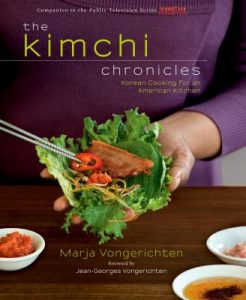 Finally, just for fun, we checked out Cook Korean! by Robin Ha. This unique book is written in graphic-novel format, which was fun to read, though it was sometimes a bit tricky to follow the flow of the drawings. And since those illustrations were drawings rather than photos, they weren’t quite as helpful at the market; we did enjoy the short comics within the book that told stories about the author’s life and cooking journey.
Finally, just for fun, we checked out Cook Korean! by Robin Ha. This unique book is written in graphic-novel format, which was fun to read, though it was sometimes a bit tricky to follow the flow of the drawings. And since those illustrations were drawings rather than photos, they weren’t quite as helpful at the market; we did enjoy the short comics within the book that told stories about the author’s life and cooking journey.
All of these books had (of course) recipes for kimchi, and a few of us took the plunge and attempted this quintessential dish. This recipe is also one of the few that necessitated a trip to a Korean market, as it requires hot pepper flakes, which are unavailable in local supermarkets. We agreed that it certainly wasn’t hard to make, though it took some time between the chopping of vegetables, salting and then draining them, combining with the seasonings, and then fermenting for a few days. Some of us used considerably less pepper flakes than was called for– but this is the virtue of making it yourself! One person thought it was a fun experiment, and the kimchi was good, but not so much so that she wanted to make it again. Some in the group don’t care for the characteristic sourness of kimchi, though this can be controlled somewhat by refrigerating the kimchi as soon as it’s made, so it ferments much more slowly. Or you could try water kimchi, which is made without red pepper and is “crunchy and refreshing.”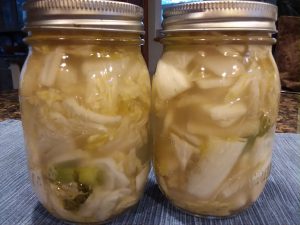
Several of the recipes in both Korean Food Made Simple and Kimchi Chronicles were Korean-inspired rather than authentically Korean; most of these were quick to make and more approachable from a Western perspective– perhaps you could say that they are “gateway recipes”! A few of us made 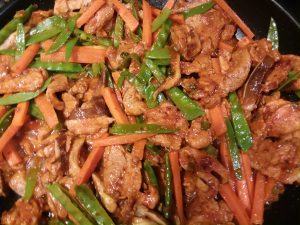 spicy pork stir-fry and thought it was absolutely delicious. The pork and vegetables were cooked in a flavorful sauce featuring gochujang (red pepper paste), a key ingredient for Korean cooks (one person discovered this ingredient at Target– so you know Korean food has really gone mainstream!). Scallion salad was a quick side dish that was “really good,” as was spice-rubbed Korean chicken. Ginger fried rice was “the best fried rice ever,” and kimchi fried rice was a tasty vehicle for kimchi– if you like kimchi. Beef bulgogi was too sweet, though the marinade was a tasty combination overall. Bibimbap made use of leftover bulgogi, as well as the traditional assortment of vegetables. Served atop rice, it’s a savory bowl of wonderful flavors and textures. All of the above recipes from Kimchi Chronicles. Both mom’s bbq chicken
spicy pork stir-fry and thought it was absolutely delicious. The pork and vegetables were cooked in a flavorful sauce featuring gochujang (red pepper paste), a key ingredient for Korean cooks (one person discovered this ingredient at Target– so you know Korean food has really gone mainstream!). Scallion salad was a quick side dish that was “really good,” as was spice-rubbed Korean chicken. Ginger fried rice was “the best fried rice ever,” and kimchi fried rice was a tasty vehicle for kimchi– if you like kimchi. Beef bulgogi was too sweet, though the marinade was a tasty combination overall. Bibimbap made use of leftover bulgogi, as well as the traditional assortment of vegetables. Served atop rice, it’s a savory bowl of wonderful flavors and textures. All of the above recipes from Kimchi Chronicles. Both mom’s bbq chicken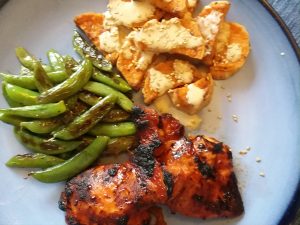 and Korean pulled pork from Korean Food Made Simple were hits– the chicken was moist and delicious with lots of flavor. It featured an excellent dipping sauce, as well. The pork was yummy and simple– savory, sweet, and spicy all at once. A keeper!
and Korean pulled pork from Korean Food Made Simple were hits– the chicken was moist and delicious with lots of flavor. It featured an excellent dipping sauce, as well. The pork was yummy and simple– savory, sweet, and spicy all at once. A keeper!
Maangchi’s book is perhaps the most authentic one we road-tested, but that didn’t stop people from diving in. Steamed eggplant was easy and a keeper, as was blanched spinach with scallions and sesame. Seafood-scallion pancakes, though different than the Chinese variety, were delicious with generous amounts of their namesake ingredients. The ridiculously simple dipping sauce was the perfect accent. Korean-style zucchini pancakes weren’t pancakes per se, but rather lightly breaded and fried zucchini slices. They were served with creamy pine nut sauce; the sweet-and-sour sauce was a good foil for the tender zucchini. Korean-style curry rice required a trip to a specialty store to buy Korean curry powder, but the completed dish was so good it was worth the effort. Panfried tofu didn’t sound like it would be tasty, but turned out to be “much better than expected;” it also had a very flavorful dipping sauce. We sampled the braised lotus root at our meeting; it was crunchy with a delicious slightly sweet glaze. A few of us tried the iconic jjajangmyeon (noodles with black bean paste). This is an extremely popular, ubiquitous dish adopted from China, but all of us who made it thought it was pretty boring. (I did think it tasted better after sitting in the fridge for a couple of days). Japchae, another classic Korean noodle dish, was excellent, with its nicely chewy noodles, stir-fried vegetables, and marinated beef.
One drawback of much of Korean cooking can be inferred from some of the above descriptions: there is a lot of prep, as most ingredients need to be diced, shredded, or cut into matchsticks. However, you do save time on the cooking end, since all those small pieces of food cook quickly. The extensive prep, and numerous sauces, also led to a mountain of dirty dishes, so be warned if you don’t have a dishwasher! Most of the recipes in these books had many common ingredients, which was good for using up our stashes of Korean sauces, pastes, and hot pepper, but sometimes that made it seem that everything had the same flavors. One quirk we discovered is that several popular Korean recipes use some distinctly American ingredients, like Spam, American cheese, canned tuna, and hot dogs– a legacy of the US’s participation in the Korean War. Many of these items show up in Korean comfort foods like stews and noodle soups. Maangchi has a recipe for kimchi stew with tuna, which sounded a bit weird but tasted delicious. Kimchi Chronicles‘ recipe for fried rice with kimchi advises us to melt American cheese on top of the finished dish, as this is considered comfort food at its finest.
Will we continue to cook Korean? For most of us, it’s not in our wheelhouse and requires extra effort in the shopping and prep department; so perhaps it would be more now-and-then rather than every week. At least now if we want Korean food we can go to a restaurant instead of having to make it ourselves; and some experience with Korean flavors and ingredients makes it easier, more fun, and more delicious when we order takeout or stop at a Korean restaurant. If you want to cook Korean yourself, any of the books we tried would be a good choice; they were all clearly written, easy to use, and loaded with explanatory photographs. Because we had four titles, we didn’t rate them, as each individual book was used by very few people.
 Our next meeting will be on Friday, June 1 at 11 AM in the Fireplace Room. Please note the date change; we will not meet on May 25 but on June 1. May’s title is Quench: handcrafted beverages to satisfy every taste and occasion by Ashley English. Copies are available at the main desk.
Our next meeting will be on Friday, June 1 at 11 AM in the Fireplace Room. Please note the date change; we will not meet on May 25 but on June 1. May’s title is Quench: handcrafted beverages to satisfy every taste and occasion by Ashley English. Copies are available at the main desk.
*Anyeong-haseyo = Hello!
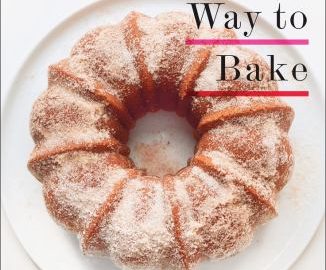
Bibliobites in March: Better Baking?
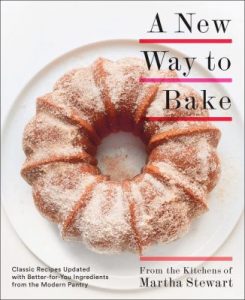 What better way to counteract the persistent snow and chill of March than by turning on the oven and baking something warm and buttery? There’s not much that’s better at warding off the late-winter-when-is-spring-ever-going-to arrive blues than a freshly baked something served up with a steaming hot cup of coffee. This month we devoted ourselves to the (mostly) sweet side of things with Martha Stewart’s A New Way to Bake, which features “classic recipes updated with better-for-you ingredients from the modern pantry.”
What better way to counteract the persistent snow and chill of March than by turning on the oven and baking something warm and buttery? There’s not much that’s better at warding off the late-winter-when-is-spring-ever-going-to arrive blues than a freshly baked something served up with a steaming hot cup of coffee. This month we devoted ourselves to the (mostly) sweet side of things with Martha Stewart’s A New Way to Bake, which features “classic recipes updated with better-for-you ingredients from the modern pantry.”
Martha Stewart has certainly been at the forefront of America’s food renaissance since the 1980s, when Entertaining made a huge splash. Her insistence on topnotch ingredients and attention to detail won her legions of fans. But these days, she seems to leave much to her staff; the “author” of our title is “the kitchens of Martha Stewart.” Obviously there’s nothing wrong with a group effort, but we felt that the book suffered a bit from the lack of ownership that a single author might have provided. There were some unexpected editing mistakes: a pancake recipe labeled “gluten-free” contained wheat flour; and some choices that made the book less user-friendly, such as not warning us when an ingredient was to be “divided”– that is, part used up front and part later. Some ingredients were listed in ways that made it harder to buy them; one recipe lists “3 cups grated zucchini,” when it would be far easier if we’d been told “1 pound zucchini, grated (3 cups)”, since we normally buy produce by weight. These are small complaints, but they did affect our overall enjoyment of the book. And this title suffered from the cardinal sin of absolutely refusing to stay open; the spine was so stiff that it was difficult to keep the book open even with a heavy weight on top (I resorted to using a large cast-iron skillet!).
But, as always, these petty annoyances will be overlooked if ultimately there are yummy results. Was that the case for our group of dedicated bakers? Read on, dear friends…..
In the breakfast department, coconut baked oatmeal was a winner: it was absolutely delicious, easy to make, and the coconut milk and ginger were perfect accents for the toothsome oats. Another standout was spiced apple and oat scones. These were moist and tender, and the spelt flour in them contributed depth and a touch of sweetness. Coconut pistachio biscotti were good for dunking, but the proportion of cornmeal was too high, which made for a gritty cookie (a better version: http://greekboston.com/cooking/paximathia/). 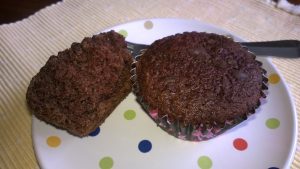 Double chocolate rye muffins had satisfying chocolate flavor, and the rye flour added a slightly bitter backnote that went well with the chocolate.
Double chocolate rye muffins had satisfying chocolate flavor, and the rye flour added a slightly bitter backnote that went well with the chocolate.
We tried several of the quick breads in this book, with mixed success. Coconut banana bread was praised for its subtle, tropical flavor. It had a beautiful texture, was moist and flavorful, and disappeared quickly! The Irish-style brown bread with whole wheat and rye flours was grainy and good– we sampled this at our meeting topped with smoked salmon and crème fraiche, which elevated it to a gourmet treat! On the down side, whole wheat date-nut bread took way longer to bake than the recipe indicated, and resulted in an inedible brick. Zucchini and chocolate loaves were OK but did not impress. Whole-grain cornbread was similarly fine but not outstanding– it tasted pretty much like any other cornbread.
Of course a few of us had to try the luscious-looking apple-cider doughnut cake which graces the cover of the book. It’s made with whole-wheat flour and olive oil, as well as applesauce and apple cider. One person thought it was heavy and didn’t have much flavor; another thought it was good, but the olive oil flavor was too strong. We sampled this at the meeting and the consensus was that it was tasty and not too olive-y. And, as it turned out, the olive flavor mellowed after a day or so. A third person had overall success with this recipe, though the apple flavor was not as strong as she would have liked. However all agreed that the cake they made looked every bit as pretty as the one on the cover!
In addition to the biscotti mentioned above, we tried pecan, oat, and dark chocolate chunk cookies. These cookies were good but fell apart when you ate them. The prescribed 1/4 cup size was too big; and overall they just weren’t good enough to bother with again. The dark chocolate spelt brownies had a nice fudgy taste, but the spelt flour imparted an unpleasant graininess. This was one recipe that tasted like it was trying a bit too hard to be healthy. Whole-wheat fig crumble squares had too much crumble and not enough filling; however, the almond-coconut macaroons, which we were fortunate to sample at our meeting, were very easy to make and a yummy treat. A keeper! And the sweet oat-walnut crisps, while a bit fussy to make, were a delicious less-sweet cookie– really more like a cracker. The coarse salt and flaxseeds added a welcome crunch and flavor.
One person bravely attempted a yeast dough, making hazelnut hot-cross buns. These were a major disappointment, producing “hockey pucks.” The dough never rose, perhaps because the instructions never have you proof your yeast before adding all the other ingredients; it was an overall epic fail! The honey whole-wheat bread did instruct you to proof your yeast, but the resulting loaf, though it looked and smelled wonderful, was still unpleasantly heavy and dense.
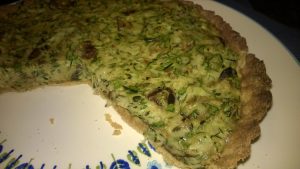 There were a few other epic fails on the savory side of things, mostly to do with various tart crusts. Mushroom tart had a half whole-wheat crust that was extremely problematic. The dough was gritty, almost impossible to knead (as instructed), and absolutely refused to come together, despite multiple tries. After buying a lot of expensive ingredients for the filling (lots of mushrooms, gruyère cheese) it was frustrating to spend so much time and energy on one component that never came out right. The filling did taste very good, though! The herb quiche with rye crust had a similarly difficult crust that ultimately was no better than crumbly. And the quantity of filling made for a very thin quiche; as with the mushroom tart, this recipe seemed like a lot of effort for a less than stellar finished product. On the other hand, chickpea-vegetable pancakes were quick, easy, and delicious; good for lunch or a snack.
There were a few other epic fails on the savory side of things, mostly to do with various tart crusts. Mushroom tart had a half whole-wheat crust that was extremely problematic. The dough was gritty, almost impossible to knead (as instructed), and absolutely refused to come together, despite multiple tries. After buying a lot of expensive ingredients for the filling (lots of mushrooms, gruyère cheese) it was frustrating to spend so much time and energy on one component that never came out right. The filling did taste very good, though! The herb quiche with rye crust had a similarly difficult crust that ultimately was no better than crumbly. And the quantity of filling made for a very thin quiche; as with the mushroom tart, this recipe seemed like a lot of effort for a less than stellar finished product. On the other hand, chickpea-vegetable pancakes were quick, easy, and delicious; good for lunch or a snack.
As should be obvious by now, everyone entered into this month’s baking with lots of energy and enthusiasm, but overall we were disappointed. We felt that with this book, Martha & Co. were simply jumping onto a trend, just swapping out white flour for something whole-grain, as opposed to developing recipes specifically designed to showcase those products. And although some recipes used oil instead of butter and less-processed sweeteners instead of white sugar, amounts certainly matched those in standard recipes; so if you’re looking to reduce fats and sugars, this is probably not the book for you. Once again our voting strongly reflected our experiences: we averaged out to 2.78 chef’s hats (out of a possible 5). One comment perhaps sums it all up: “My husband was so happy to see this book go back to the library!”
If you’re interested in whole-grain baking, here are a couple of titles that are worth checking out: Good to the Grain by Kim Boyce; or Better Baking by Genevieve Ko.
Our next meeting will be Friday, April 27 at 11 AM in the Fireplace Room. We’ll be in uncharted waters, learning about – and cooking Korean food! There are multiple titles; please choose one. All are available at the main desk. Guettae manna! (See you then! in Korean, according to Google Translate).
Bacon Sandwich
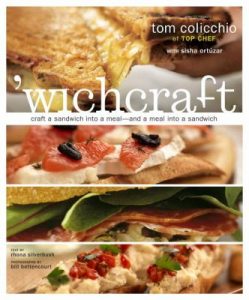 In February, Bibliobites members made lots of sandwiches from that month’s book, ‘wichcraft by Tom Colicchio. Thinking about sandwiches, making them, and eating them brought back a long-ago memory for me. Readers, have you ever enjoyed a transcendent sandwich? A combination of time, place, and ingredients that turned an everyday lunch into a blissful eating experience?
In February, Bibliobites members made lots of sandwiches from that month’s book, ‘wichcraft by Tom Colicchio. Thinking about sandwiches, making them, and eating them brought back a long-ago memory for me. Readers, have you ever enjoyed a transcendent sandwich? A combination of time, place, and ingredients that turned an everyday lunch into a blissful eating experience?
………It’s the mid-60s, and I am eight or nine years old. It’s summer vacation and the day is warm and sunny. I’m spending the day with my friend Colleen, at her great-aunt’s house in Freeport, NY, a town near the shore. The small white house has a velvety bright green lawn sloping down to a canal where we can see rows of glossy boats tethered to their docks. Noisy gulls circle endlessly overhead in a cloudless blue sky. We’re sitting on the grass not doing much of anything, enjoying our freedom and the sunshine. 
We’re here today because Mrs. Connolly, Colleen’s mom, is helping to take care of her aunt. The aunt is elderly and is ill with something that means she stays in bed in a darkened room. Looking back, I think she must have had a stroke or something similar involving a long convalescence, but at the time the aunt’s woes are of no concern to me. I am a little scared I may have to meet this unknown old person and even talk to her, but as it turns out we girls hardly set foot in the cool, dim house. Mrs. Connolly disappears into the kitchen, and we go outside into the stunning day.
 So there we are on the grass, leaning back propped up on our elbows, squinting at the water, and Mrs. Connolly comes towards us. She’s carrying two plates with sandwiches on them, and I suddenly realize it’s lunchtime and I’m hungry. She puts down the plates, and probably a glass of something to drink, too, but I don’t notice because I am amazed and thrilled by what’s been set in front of me: a whole sandwich filled with nothing but BACON! Now you have to understand that, like most kids (like most people!) I really like bacon; but it’s something doled out infrequently and in small quantities at my house. Whereas now, on my plate I see a generous length of soft Italian bread stuffed with MANY slices of salty, porky, fatty goodness, and it’s ALL FOR ME! I take a big bite and practically swoon with the perfection of it all—the tender, floury bread; the soul-satisfying smoky crispiness of the bacon—and nothing else. No mayo, or mustard, or lettuce, or tomato; nothing to interfere with that blessed bacon-ness. I devour every last crumb, with gusto.
So there we are on the grass, leaning back propped up on our elbows, squinting at the water, and Mrs. Connolly comes towards us. She’s carrying two plates with sandwiches on them, and I suddenly realize it’s lunchtime and I’m hungry. She puts down the plates, and probably a glass of something to drink, too, but I don’t notice because I am amazed and thrilled by what’s been set in front of me: a whole sandwich filled with nothing but BACON! Now you have to understand that, like most kids (like most people!) I really like bacon; but it’s something doled out infrequently and in small quantities at my house. Whereas now, on my plate I see a generous length of soft Italian bread stuffed with MANY slices of salty, porky, fatty goodness, and it’s ALL FOR ME! I take a big bite and practically swoon with the perfection of it all—the tender, floury bread; the soul-satisfying smoky crispiness of the bacon—and nothing else. No mayo, or mustard, or lettuce, or tomato; nothing to interfere with that blessed bacon-ness. I devour every last crumb, with gusto.
I honestly don’t remember anything else about that day; but the combination of the idyllic setting, the sun-soaked day, and the unexpected treat created an unforgettable for me. Most likely, Mrs. Connolly made that lunch for us because there wasn’t much else to eat in the house, and it was something quick and easy (this was well before the advent of microwaves). I’m sure she had no idea that I would think that sandwich was so incredible, but I’ve never forgotten it.
Love sandwiches? Love bacon? Then check out these titles: A Super Upsetting Cookbook About Sandwiches by Tyler Kord; Panini, Bruschetta, Crostini: Sandwiches Italian Style by Viana LaPlace; 300 Sandwiches: A Multi-layered Love Story—With Recipes by Stephanie Smith; The Banh Mi Handbook by Andrea Nguyen; Bacon Nation: 125 Irresistible Recipes by Peter Kaminsky; Seduced by Bacon by Joanna Pruess.
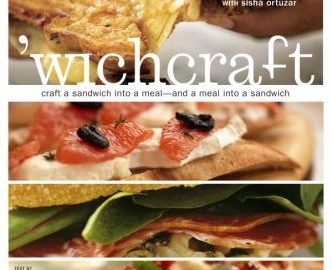
Bibliobites in February: ‘wich Sandwich?
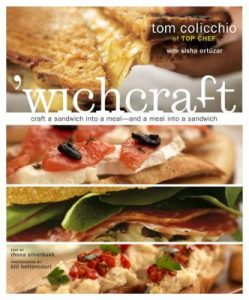 The humble sandwich is ubiquitous in most of our lives; just think about how often you’ve slapped together a PB & J or downed a “to-go” breakfast sandwich on your way to work. And how many times has a grilled cheese or BLT or Reuben just hit the spot, speedily satisfying hunger in a way few other things can? Author and Top Chef judge Tom Colicchio, along with his partner Sisha Ortuzar, recognized that most people enjoy and eat a lot of sandwiches– so they decided to kick it up a notch (so to speak) and open a café where sandwiches were produced with the same care and quality that goes into a “real” restaurant meal. Accordingly, the partners opened ‘wichcraft in New York City; and this month’s title, ‘wichcraft, is a compendium of many of the sandwiches served at the café. Did our group enjoy their month of meals served between two slices of (artisan) bread?
The humble sandwich is ubiquitous in most of our lives; just think about how often you’ve slapped together a PB & J or downed a “to-go” breakfast sandwich on your way to work. And how many times has a grilled cheese or BLT or Reuben just hit the spot, speedily satisfying hunger in a way few other things can? Author and Top Chef judge Tom Colicchio, along with his partner Sisha Ortuzar, recognized that most people enjoy and eat a lot of sandwiches– so they decided to kick it up a notch (so to speak) and open a café where sandwiches were produced with the same care and quality that goes into a “real” restaurant meal. Accordingly, the partners opened ‘wichcraft in New York City; and this month’s title, ‘wichcraft, is a compendium of many of the sandwiches served at the café. Did our group enjoy their month of meals served between two slices of (artisan) bread?
This book easily drew us in with its lush, up-close photographs. There’s a full-page photo of every sandwich next to its recipe; and the table of contents also has a photo next to each sandwich’s name. This made things easy to find, and easy to drool over! The book is divided into breakfast sandwiches, cold or warm sandwiches, and sweet sandwiches. Since it’s still winter, most of us focused on the warm sandwiches! Surprisingly, no one tackled a sweet sandwich; these were mostly of the cake-and-ice-cream variety. Perhaps it’s still too chilly out to think about eating ice cream?
When we all got down to cooking, there was one complaint that was repeated several times: many (if not most) of these sandwich creations required substantial advance work. Meat had to be roasted, or onions had to be caramelized, or relish had to be made. Some of the condiments had multiple components that all required prep. In a restaurant, it’s likely that many of these items would be regularly made in large quantity and therefore be readily available; but at home it seemed like a lot of effort to assemble all the elements of a given sandwich. And most of the time you didn’t use up the sauce or relish you had made, and were left finding another use for it. So there were some practical aspects of these recipes that could be a bit frustrating.
But we persevered nonetheless…a few people tried the gruyère with caramelized onions, which was tasty, though of course you had to roast the onions first! One person mentioned a similar recipe from the first Smitten Kitchen book which she felt was better– but it’s probably pretty hard to go wrong with onions and melted cheese! The 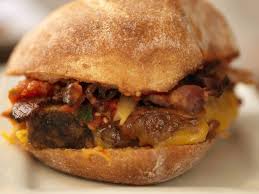 meatloaf with cheddar, bacon, and tomato relish was an excellent combination; the meatloaf itself, though very simple, was just right for the recipe. Be forewarned, though– you need to make the tomato relish, which requires that you first make the pickled mustard seeds that go into it! Another yummy meat-based sandwich was red wine-braised flank steak with roasted peppers, onions, and gruyère. This definitely required planning ahead, as the meat had to braise for 2 1/2 hours; also peppers had to be roasted and onions grilled. But it was a fantastic, if messy, meal. Roasted pork loin with prunes, dandelion greens, and mustard was commended for its top-notch sauce; and the roasted turkey with avocado, bacon, balsamic onion marmalade, and mayonnaise was a satisfying, if not totally original, combination. The onion marmalade was “good enough to eat on its own” and even made a fine topping for crackers, as we discovered at our meeting.
meatloaf with cheddar, bacon, and tomato relish was an excellent combination; the meatloaf itself, though very simple, was just right for the recipe. Be forewarned, though– you need to make the tomato relish, which requires that you first make the pickled mustard seeds that go into it! Another yummy meat-based sandwich was red wine-braised flank steak with roasted peppers, onions, and gruyère. This definitely required planning ahead, as the meat had to braise for 2 1/2 hours; also peppers had to be roasted and onions grilled. But it was a fantastic, if messy, meal. Roasted pork loin with prunes, dandelion greens, and mustard was commended for its top-notch sauce; and the roasted turkey with avocado, bacon, balsamic onion marmalade, and mayonnaise was a satisfying, if not totally original, combination. The onion marmalade was “good enough to eat on its own” and even made a fine topping for crackers, as we discovered at our meeting.
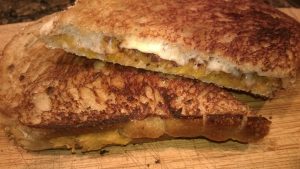 Roasted pumpkin with mozzarella and hazelnut brown butter was a winner– the hazelnut brown butter was exceptional. This was one condiment for which it was easy to imagine finding several other uses. At the meeting we sampled pan-fried eggplant with buffalo mozzarella, white anchovies, and raisin-pinenut relish; all the ingredients melded into a delicious whole. We also tasted chicken salad with walnuts, roasted tomatoes, pickled red onions, and frisée. As with many other recipes, the condiments were what made this sandwich really stand out. Roasted shrimp salad with tomatoes and olives was “a perfect summer recipe!” The bread wasn’t even necessary, as this combination made a wonderful salad. Roasted asparagus with red onions, basil, and vacherin was an uncomplicated open-faced sandwich; if vacherin is a bit too pricey you can use any cheese that melts easily. And
Roasted pumpkin with mozzarella and hazelnut brown butter was a winner– the hazelnut brown butter was exceptional. This was one condiment for which it was easy to imagine finding several other uses. At the meeting we sampled pan-fried eggplant with buffalo mozzarella, white anchovies, and raisin-pinenut relish; all the ingredients melded into a delicious whole. We also tasted chicken salad with walnuts, roasted tomatoes, pickled red onions, and frisée. As with many other recipes, the condiments were what made this sandwich really stand out. Roasted shrimp salad with tomatoes and olives was “a perfect summer recipe!” The bread wasn’t even necessary, as this combination made a wonderful salad. Roasted asparagus with red onions, basil, and vacherin was an uncomplicated open-faced sandwich; if vacherin is a bit too pricey you can use any cheese that melts easily. And 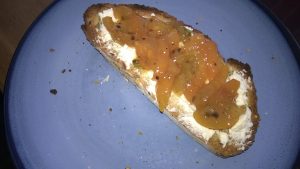 kumquat-rosemary marmalade with goat cheese, also open-faced, was a great way to try kumquats, which are in season from November to March. The tart, slightly bitter marmalade was a perfect foil for the creamy goat cheese.
kumquat-rosemary marmalade with goat cheese, also open-faced, was a great way to try kumquats, which are in season from November to March. The tart, slightly bitter marmalade was a perfect foil for the creamy goat cheese.
Despite the time involved, most of us had to agree that the various condiments added flavor and sophistication to the recipes; they were delicious on their own and had many potential uses. And once all was assembled, the sandwiches themselves were quite good. But since we think of a sandwich as a quick meal, it was hard to change our mindset; these sandwiches were really a full meal that just happened to be eaten between slices of bread– and took as much time to create as a complete dinner! We also noted that many of these sandwiches were pretty messy to eat, and wondered whether this ever bothered customers at the café. Perhaps café staff are better at stacking and containing ingredients than we are? We thought this book might be nice to have on hand for certain types of entertaining, like a special lunch or an upscale tailgate. The recipes are definitely a cut above your everyday sandwich, but it was enough of an effort that we just wanted someone else to make it for us. Perhaps we need a road trip to Manhattan to see how the experts do it! Our voting reflected this ambivalence, and we averaged out to 2.6 chef’s hats (out of a possible 5).
 Next month we’ll be delving into Martha Stewart’s A New Way to Bake. This title features a wide variety of baked goods showcasing less-common sweeteners and whole-grain flours. Copies are available at the main desk. Our next meeting will be on Friday, March 30 at 11 AM in the Fireplace Room. Hope to see you there, and happy baking!
Next month we’ll be delving into Martha Stewart’s A New Way to Bake. This title features a wide variety of baked goods showcasing less-common sweeteners and whole-grain flours. Copies are available at the main desk. Our next meeting will be on Friday, March 30 at 11 AM in the Fireplace Room. Hope to see you there, and happy baking!
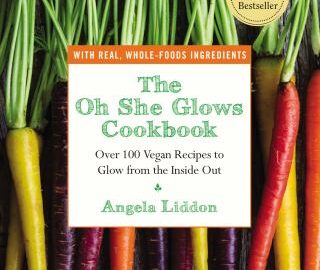
Bibliobites in January: V is for Vegan
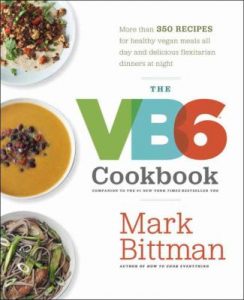 When you hear the word “vegan,” what comes to mind? Do you picture that old stereotype of an aging hippie hunched over a bowl of brown rice and vegetables? Or do you imagine Brooklyn hipsters scarfing down kale chips at a trendy bistro? Maybe it’s Tom Brady you think of, who credits an almost-vegan diet with being one of the keys to his playing longevity. Or perhaps you know someone who’s ethically opposed to eating animals in any form; or you have a friend, neighbor, or sibling who’s committed to a plant-based diet because of health or environmental concerns. While being a vegan isn’t quite a mainstream choice, it’s no longer “out there” as it was even five years ago. For evidence of this burgeoning trend, look no further than the library’s catalog, which lists 67 titles about vegan cooking! This month, our group experimented with the world of meat- and dairy-free cooking with two titles: The VB6 Cookbook by the prolific Mark Bittman, and The Oh She Glows Cookbook by blogger Angela Liddon.
When you hear the word “vegan,” what comes to mind? Do you picture that old stereotype of an aging hippie hunched over a bowl of brown rice and vegetables? Or do you imagine Brooklyn hipsters scarfing down kale chips at a trendy bistro? Maybe it’s Tom Brady you think of, who credits an almost-vegan diet with being one of the keys to his playing longevity. Or perhaps you know someone who’s ethically opposed to eating animals in any form; or you have a friend, neighbor, or sibling who’s committed to a plant-based diet because of health or environmental concerns. While being a vegan isn’t quite a mainstream choice, it’s no longer “out there” as it was even five years ago. For evidence of this burgeoning trend, look no further than the library’s catalog, which lists 67 titles about vegan cooking! This month, our group experimented with the world of meat- and dairy-free cooking with two titles: The VB6 Cookbook by the prolific Mark Bittman, and The Oh She Glows Cookbook by blogger Angela Liddon.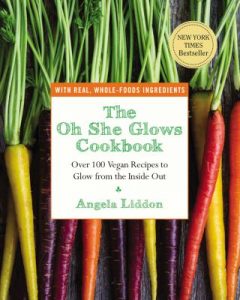
To begin our meeting, I asked everyone to describe the month’s experiences with one word. As always, opinions were forthright and varied wildly: “unsatisfying;” “boring;” “interesting;” “just….no;” “healthy;” “unappetizing;” “surprising;” and “surprisingly good.” Those strongly in the negative fell into a few camps: some do not like beans, or live with those who refuse to eat them. Others could not fathom purposely eliminating the “good stuff,” like cheese or meat; and some have dietary restrictions that already complicate meal planning, so adding the changes veganism requires is difficult or not advisable. But despite misgivings, most people persevered, and some discovered recipes that they’d be happy to include in their regular rotation.
Bittman’s book addresses some concerns regarding giving up favorite foods with his VB6 diet plan, in which participants are vegan-only before 6 PM, but eat omnivorously for dinner. Accordingly, the book has recipes of both types; but in general no one was impressed with this title. Orange soup with black salsa was “OK,” though the vegetable stock used in it was quite good. Both the African-style chicken stew and red paella with scallops didn’t seem to have enough seasoning and were “bland,” and ham hash with greens similarly lacked oomph. 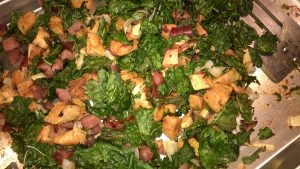 Spaghetti with bean Bolognese had an appropriately thick sauce, and overall was an enjoyable dish; but the cauliflower Romesco was just “OK,” while the eggplant meatballs were not a hit. They held together well but the proportion of breadcrumbs was too high, and were therefore over-evident in the final dish. The meatballs were served with all-purpose tomato sauce, which was “good,” but nothing out of the ordinary. The ribollita soup, a traditional Tuscan dish, was “really good,” and the sweet potato shepherd’s pie was a tasty version of this classic casserole.
Spaghetti with bean Bolognese had an appropriately thick sauce, and overall was an enjoyable dish; but the cauliflower Romesco was just “OK,” while the eggplant meatballs were not a hit. They held together well but the proportion of breadcrumbs was too high, and were therefore over-evident in the final dish. The meatballs were served with all-purpose tomato sauce, which was “good,” but nothing out of the ordinary. The ribollita soup, a traditional Tuscan dish, was “really good,” and the sweet potato shepherd’s pie was a tasty version of this classic casserole. 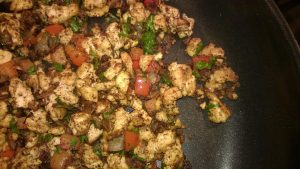 Chorizo tacos featured tofu subbing for the sausage; it was better than expected but “not a keeper.” Banana-chocolate ice cream was much better than expected, and was a creamy treat. This dessert is based on frozen bananas; one tip mentioned was to peel the bananas before you freeze them, since it’s way more difficult to peel them once they’re frozen. Also, this is one recipe for which you must have a food processor or a powerful blender. You could top your ice cream with coco-oat-nut granola, which was good and easy to make.
Chorizo tacos featured tofu subbing for the sausage; it was better than expected but “not a keeper.” Banana-chocolate ice cream was much better than expected, and was a creamy treat. This dessert is based on frozen bananas; one tip mentioned was to peel the bananas before you freeze them, since it’s way more difficult to peel them once they’re frozen. Also, this is one recipe for which you must have a food processor or a powerful blender. You could top your ice cream with coco-oat-nut granola, which was good and easy to make.
Liddon’s “Oh She Glows Cookbook” gets my vote for “worst name ever for a cookbook” (and blog for that matter), but obviously this doesn’t bother her legions of fans around the world. There were hits and misses from this title as well, but those who used it were mostly pleasantly surprised by how much they enjoyed what they tried. Maple-cinnamon apple & pear baked oatmeal made a delicious and hearty breakfast; it can be made ahead, always a plus. Present glo bars were a no-bake granola bar that include puffed rice cereal, which makes for a lighter, crispier bar. The bars were tasty but tended to fall apart once outside of the refrigerator, so they’re not as portable as you might hope.  10-spice vegetable soup with cashew cream, despite the enticing name, turned out to be your basic vegetable soup, but the Indian lentil-cauliflower soup was excellent, with a nice combination of spices. You could accompany your soup with spiced toasted pita chips, which were flavorful and not overly spicy. Lentil-walnut loaf was surprisingly delicious; it had a balsamic-apple glaze which seemed to have a weird combination of ingredients– but it turned out to be a perfect accent for the loaf. Other keepers were the crowd-pleasing Tex-Mex casserole,
10-spice vegetable soup with cashew cream, despite the enticing name, turned out to be your basic vegetable soup, but the Indian lentil-cauliflower soup was excellent, with a nice combination of spices. You could accompany your soup with spiced toasted pita chips, which were flavorful and not overly spicy. Lentil-walnut loaf was surprisingly delicious; it had a balsamic-apple glaze which seemed to have a weird combination of ingredients– but it turned out to be a perfect accent for the loaf. Other keepers were the crowd-pleasing Tex-Mex casserole, basically a vegan version of a taco casserole; and the soul-soothing African peanut stew (note to Mark Bittman: this one is really good!).
basically a vegan version of a taco casserole; and the soul-soothing African peanut stew (note to Mark Bittman: this one is really good!).
Liddon has a newer book as well, Oh She Glows Every Day, and one person tried it out. Again, there were some recipes that missed the mark; but there was still a lot to like. The fastest sprouted steel-cut oatmeal was a make-ahead breakfast; similar to other “overnight oats” recipes, you soak your oats overnight to speed up the morning’s cooking. We’re not sure if this is really sprouting your oats, but it’s a good technique anyway. The berry chia seed jam was a clever use of the thickening power of these seeds, and was a quick way to make a small batch of jam. The jam came in handy for the strawberry oat crumble bars, which were “surprisingly good.” Chia seeds also came into play in coconut chia seed pudding, but in this case the result was “yuck!” The texture of the chia seeds in this recipe was unpleasant and overwhelming. And though the lemon-tahini dressing wasn’t enjoyable, the Thai almond butter sauce was addictive– as advertised! 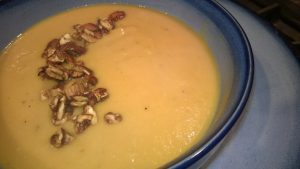 Creamy Thai carrot sweet potato soup was flavorful, but what really made this dish was its garnish of salty, crunchy roasted tamari almonds. One general complaint about the book’s salad recipes is that they frequently feature several ingredients that require advance prep; if you like this type of cooking (and have the time) it works well, but it’s not so good when you’re looking for a last-minute meal.
Creamy Thai carrot sweet potato soup was flavorful, but what really made this dish was its garnish of salty, crunchy roasted tamari almonds. One general complaint about the book’s salad recipes is that they frequently feature several ingredients that require advance prep; if you like this type of cooking (and have the time) it works well, but it’s not so good when you’re looking for a last-minute meal.
Overall, group members felt that this type of cooking required lots of ingredients that were difficult to find and/or were expensive. Many didn’t like that plant-based cooking often requires planning ahead, as in making sure you have cooked grains, beans, or veggies at the ready– otherwise dinner could easily take more than an hour to assemble. Breakfast was difficult for some; both books tout smoothies as a fast breakfast option, but if you like a bit of chew in the morning that’s not going to work for you. Oatmeal in its many forms is a good option, but that’s another breakfast choice that has strong proponents and detractors! Lunch also could get more complicated than expected– sandwich fillings (with the exception of the ever-reliable PB&J) required some forethought and prep, as do the aforementioned salads. Dinner leftovers are probably your best option; but for some this meant consuming more beans and grains than they really wanted to.
What plant-based cooking may come down to for most of us is that we need a strong reason to make this labor-intensive switch. As Mark Bittman points out, his choice was either to change his diet or accept a lifetime of medication. That’s pretty good motivation, and one that’s obviously worked for him. Angela Liddon felt that a plant-based, whole-foods diet aided in her recovery from an eating disorder; and others (most notably Rip Esselstyn of Engine 2 fame) credit this way of eating with improving their overall health and sharply reducing their risk of cardiovascular disease. Those in our group who significantly altered their eating patterns for the month didn’t report feeling much different or better in any way– but you might expect that those in a group interested in cooking probably eat fairly well already. It’s worth pointing out that many common dishes are intrinsically vegan– we just don’t think of them that way, because they’re familiar. Whether we realize it or not, many of us are already part-time vegans!
As for the books themselves, both were large-format, which enabled them to (mostly) stay open when cooking. Bittman’s book has more photos than some of his other books, which was a plus. In his typical fashion, at the end of a recipe he provides a couple of variations, as well as alternative ingredients. Some really appreciate this feature; others find it overwhelming and distracting. We’ll give him points for thoroughness, though!
Liddon’s book has full-page photos of almost every recipe, but the photos were criticized for being “gelatinous;” they had a shiny, almost fake look that we didn’t care for, though some were better than others. There are also numerous photos of the photogenic author and her family, which fans of her blog probably adore, but which got to be a bit much for the rest of us. Many people commented negatively on the excessive “perkiness” of her headnotes, and the writing itself seemed a bit awkward; perhaps her editors were reluctant to alter her “voice” with which so many are familiar. But, overall her recipes were more interesting and engaging than Bittman’s. Points to her for that!
Speaking of points….in our final voting, VB6 averaged out to 2 chef’s hats (out of a possible 5); while Oh She Glows barely squeaked in to a 3. Ouch! Clearly neither book converted anyone in the group to a plant-based diet.
 We’ll next meet on February 23 at 11 AM in the Fireplace Room. We’ll be living life between two slices of bread with Top Chef‘s Tom Colicchio’s ‘wichcraft. Copies are available at the main desk. Hope to see you there!
We’ll next meet on February 23 at 11 AM in the Fireplace Room. We’ll be living life between two slices of bread with Top Chef‘s Tom Colicchio’s ‘wichcraft. Copies are available at the main desk. Hope to see you there!
Postscript: If you’ve read all of the above, you may be wondering about the two terms I’ve used: “plant-based diet” versus “vegan.” Initially I thought they were the same thing, but a comment I overheard made me wonder if they were. A quick, and admittedly unscientific, internet search revealed the following: a plant-based diet (sometimes also called a whole-foods plant-based diet) promotes consumption of whole grains, legumes, fruits, and vegetables for health-based reasons. One can include small amounts of animal products, but the overriding emphasis is on plant-based, unprocessed foods. Vegans consume only plant-based foods, and are also ethically committed to abstaining from using animal products in any aspects of their lives– for instance, vegans do not wear leather or wool sweaters. Theoretically, vegans aren’t necessarily committed to a whole-foods approach (as many articles like to point out, Oreos and potato chips are vegan)– but this is likely more a matter of semantics than practical application. And speaking of semantics, the two terms have come to be used somewhat interchangeably, though right now “vegan” seems to be the more common usage, if only because it’s quicker to say and is understood to be shorthand for “eating only plant-based foods.” But there is a difference, and it will be interesting to see how this plays out in the coming years, especially if this type of eating continues to become more common.
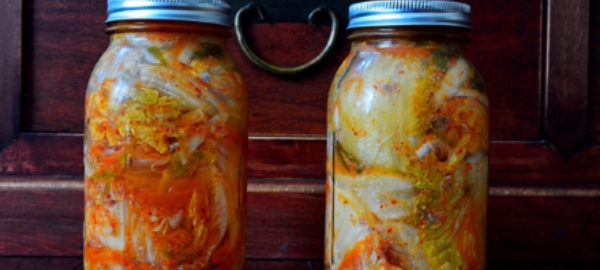
Nephew’s Kimchi – Korean Comfort Food
 Nephew is an Asianophile. Or is it Asiaphile? Though I’m not sure which term is correct, Nephew (your basic southern/eastern European mutt) greatly enjoys the cultures and foods of East Asia. He’s taught English in Taipei, Taiwan and Seoul, S. Korea, living in each for more than a year. He’s traveled in Vietnam and Thailand, and his current job takes him to China several times a year.
Nephew is an Asianophile. Or is it Asiaphile? Though I’m not sure which term is correct, Nephew (your basic southern/eastern European mutt) greatly enjoys the cultures and foods of East Asia. He’s taught English in Taipei, Taiwan and Seoul, S. Korea, living in each for more than a year. He’s traveled in Vietnam and Thailand, and his current job takes him to China several times a year.
Nephew’s living in Seoul was what first made me pay attention to Korean food; and coincidentally, it was at about that time (2012) when Korean restaurants started appearing in the Boston area. It was an adventure to wade into a cuisine which is unique and new to me, but also partially familiar as it uses some ingredients common to many Asian cultures. It was also around this time that HMart opened a store in Burlington, MA. Though there are several Asian markets in our area– there’s V-Mart in Lowell, Shin Shin in Lawrence, Chung Ge in Ayer, and M & H Oriental Food Market right here in Chelmsford– I went to HMart because I was intrigued by the idea of a Market Basket-sized store devoted to Korean food. Hmart and markets like it contain a world of food about which I knew (and still know) very little—and the lack of consistent English labeling frequently made my explorations both more puzzling and more interesting. But I’m still fascinated by the many kinds of kimchi, the innumerable types of noodles and rice, the vast stocks of gojuchang and red pepper flakes, and the array of cabbage varieties. I enjoy perusing the (to me) inscrutable labels on all kinds of shiny bags of crunchy snacks, some of which I may recognize as rice-based, but some whose contents will forever remain a mystery.
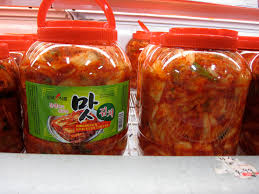 Since kimchi is one of the signature foods of Korean cuisine (probably the signature food), that was one of the things I bought at HMart, and it certainly appeared at every meal I ate in a Korean restaurant. I always tried to buy/order a mild variety, so as not set my lips on fire, but I wasn’t always successful. What Koreans think of as mild was still pretty zippy to me! At first I wasn’t even sure I liked the flavor all that much—it’s pickle-y, garlicky, spicy, and sour—but the more of it I ate, the more I came to appreciate its simple yet complex nature. And it’s like the little black dress of Korean food—it goes with everything, it can work solo or harmonize with other ingredients, and is available in many styles!
Since kimchi is one of the signature foods of Korean cuisine (probably the signature food), that was one of the things I bought at HMart, and it certainly appeared at every meal I ate in a Korean restaurant. I always tried to buy/order a mild variety, so as not set my lips on fire, but I wasn’t always successful. What Koreans think of as mild was still pretty zippy to me! At first I wasn’t even sure I liked the flavor all that much—it’s pickle-y, garlicky, spicy, and sour—but the more of it I ate, the more I came to appreciate its simple yet complex nature. And it’s like the little black dress of Korean food—it goes with everything, it can work solo or harmonize with other ingredients, and is available in many styles!
So a few months ago, I got it into my head that I wanted to make a batch of kimchi myself. I knew Nephew had tried making kimchi while in Seoul; and since he now lives in Boston I figured I could get him to help me and give me good advice about ingredients and preparation. He was up for the challenge, and we planned a Columbus Day kimchi-thon. Nephew clued me in to a blog and videos created by Maangchi, a Korean living in the US. Her explanations and photographs made the process seem easy, so off I went in quest of ingredients, almost all of which are now available in your basic large American supermarket. I did go to HMart for the essential Korean red pepper flakes and a Korean radish (though the more readily available daikon is an acceptable substitute); also some sweet rice flour, which is not sweet but is extra-starchy, and is needed to keep the kimchi from being watery.
In Korea, making kimchi can be a community affair, with friends and neighbors working together to make enough kimchi to last a family all year. Needless to say, I made a much smaller quantity; the recipe I chose is called “Easy Kimchi” on Maangchi’s website.
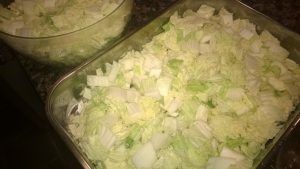
So: first, I chopped the cabbage (eight pounds worth!), and salted it thoroughly. We left it alone for a while to wilt; then drained it, rinsed it, and set it aside.
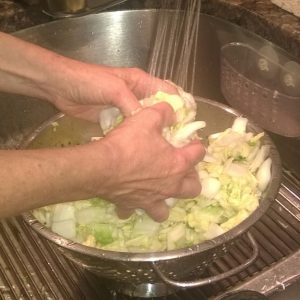
Nephew turned out to be an ace julienne-er, efficiently slivering neat piles of carrot, radish, green onions, and leek.
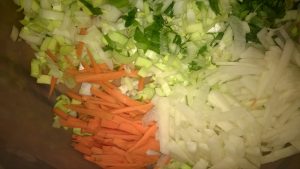
While he was chopping, I made the “porridge,” a mixture of water and sweet rice flour that is heated until thickened, like a custard. Then I added a little bit of sugar, lots of fish sauce and garlic, fresh ginger, and frightening amounts of red pepper flakes—though not nearly as much as the recipe recommended.
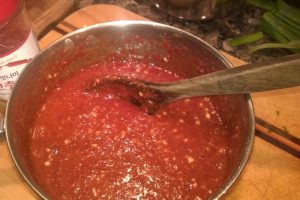 When the porridge had cooled, we combined it with Nephew’s vegetables. Finally, it was on to the big time: putting on our latex gloves (yes, the gloved hands do look a little bit creepy here!) and mixing the cabbage with the porridge and vegetables.
When the porridge had cooled, we combined it with Nephew’s vegetables. Finally, it was on to the big time: putting on our latex gloves (yes, the gloved hands do look a little bit creepy here!) and mixing the cabbage with the porridge and vegetables.
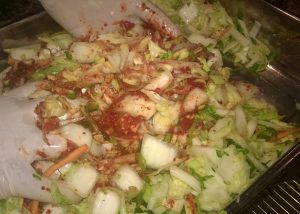
You can eat the kimchi as soon as it’s made, which we did that day; and if you don’t want it to ferment, you put it in the fridge right away.
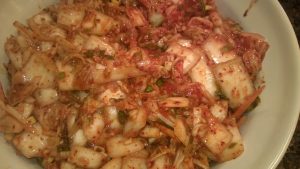
I left mine out on the counter, in a covered container, to see what would happen. After a few days, little bubbles appeared in the liquid, and we started smelling that pickle-ish, sour smell (which sounds bad but isn’t). So we knew it was fermenting; I tasted every few days to get an idea of what it was doing. I didn’t want it to get too strong, so after a couple of weeks I put it in the fridge. It will still continue to ferment, but very slowly.
That first night, I made some bibimbap and we had that with kimchi on top, though I don’t think that’s authentic. Bibimbap is another iconic Korean dish: a bowl of rice topped with various seasoned vegetables and meat and a sunnyside-up egg. You mush it all together and then slurp it up! 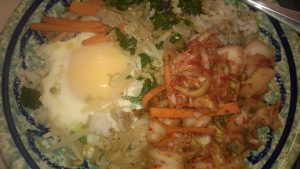 It’s comfort in a bowl and has become one of my favorite things to eat. Having homemade kimchi to go with it was just the icing on the cake, so to speak. I hope that’s OK with any Koreans who might be reading this post. Or Nephew, for that matter!
It’s comfort in a bowl and has become one of my favorite things to eat. Having homemade kimchi to go with it was just the icing on the cake, so to speak. I hope that’s OK with any Koreans who might be reading this post. Or Nephew, for that matter!
If you want to try making Korean food at home, check out some of our consortium’s titles. Note that Maangchi has now published a book—I’m going to have to take a look at that one myself.

Bibliobites in November/December: Perusing Periodicals
 It’s an embarrassment of riches when it comes to locating new or different recipes. There are infinite online resources: websites, blogs, Facebook interest groups, Tumblr posts. Can you tweet a recipe?? If you can do it in 280 characters you can! Still, many of us still enjoy the printed format, as there’s certainly no lack of books, magazines, or newspaper articles that focus on food and cooking. If we want to look up how to use a specific ingredient, or we need a certain cookie recipe stat, for the sake of speed most of us will turn to the internet. But there’s something to be said for browsing through a book or magazine and finding something scrumptious in an unexpected and serendipitous fashion. Accordingly, this month our group took on the world of periodicals both familiar and not, just to see what we would see.
It’s an embarrassment of riches when it comes to locating new or different recipes. There are infinite online resources: websites, blogs, Facebook interest groups, Tumblr posts. Can you tweet a recipe?? If you can do it in 280 characters you can! Still, many of us still enjoy the printed format, as there’s certainly no lack of books, magazines, or newspaper articles that focus on food and cooking. If we want to look up how to use a specific ingredient, or we need a certain cookie recipe stat, for the sake of speed most of us will turn to the internet. But there’s something to be said for browsing through a book or magazine and finding something scrumptious in an unexpected and serendipitous fashion. Accordingly, this month our group took on the world of periodicals both familiar and not, just to see what we would see.
Group members were free to use any periodical they preferred: old, new, food-focused or general interest. Many of us have favorites that we typically turn to, but this month gave us the opportunity to (if we chose) to find something new. An easy way to browse “print” magazines is through the library’s RBdigital (the app formerly known as Zinio). This is a quick and easy way to explore periodicals that may not be widely available in printed form– or to read an issue of a magazine when the print copy is checked out.
 One surprise for me in the general-interest category was the venerable Family Circle. Though this magazine has an old-school reputation, it’s obvious that they’ve kept up with the many changes in our cooking and eating habits. They were on-trend with a sheet pan recipe for kielbasa with cheese tortellini, and one for fish chowder! Other members tried FC’s miso sesame green beans, za’atar roasted carrots with yogurt, and curried cranberry chutney— all of which were very good. Also excellent were a Persian cauliflower rice and a sweet potato bread pudding, which turned out to be a great breakfast dish. But, sweet potato biscuits were just OK, as they didn’t have enough of their namesake flavor. They had a pretty color, though!
One surprise for me in the general-interest category was the venerable Family Circle. Though this magazine has an old-school reputation, it’s obvious that they’ve kept up with the many changes in our cooking and eating habits. They were on-trend with a sheet pan recipe for kielbasa with cheese tortellini, and one for fish chowder! Other members tried FC’s miso sesame green beans, za’atar roasted carrots with yogurt, and curried cranberry chutney— all of which were very good. Also excellent were a Persian cauliflower rice and a sweet potato bread pudding, which turned out to be a great breakfast dish. But, sweet potato biscuits were just OK, as they didn’t have enough of their namesake flavor. They had a pretty color, though!
 Good Housekeeping is another magazine that’s been around for generations; and their December issue typically features a slew of Christmas cookie recipes. One person tried their stained glass cookies, but the recipe didn’t work quite right; though the cookies looked enticing, they didn’t taste good and were tooth-breakers! My favorite GH cookie recipe is their tri-color almond slices, better known as Italian rainbow cookies. While you have to fuss a bit to make them, when finished they look appropriately fancy and taste yummy.
Good Housekeeping is another magazine that’s been around for generations; and their December issue typically features a slew of Christmas cookie recipes. One person tried their stained glass cookies, but the recipe didn’t work quite right; though the cookies looked enticing, they didn’t taste good and were tooth-breakers! My favorite GH cookie recipe is their tri-color almond slices, better known as Italian rainbow cookies. While you have to fuss a bit to make them, when finished they look appropriately fancy and taste yummy.
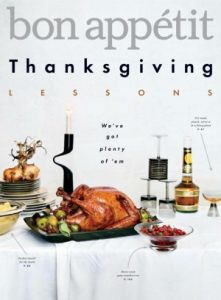 As for food-focused magazines, a few people perused Bon Appetit. Many of us remember how exciting and influential this magazine was in the 1990s, but there was general consensus that it’s just not what it used to be, and no one was enthusiastic about anything they saw in a current issue. There was a lot of talk about favorite tried-and-true BA recipes from “back then” — well-loved dishes that we continue to make today. One perennial favorite is the pumpkin cheesecake with gingersnap crust; another keeper is the penne with tomatoes, olives and two cheeses. Fine Cooking is also a magazine that’s been around for a while and those who use it think it’s as good as ever. And, the
As for food-focused magazines, a few people perused Bon Appetit. Many of us remember how exciting and influential this magazine was in the 1990s, but there was general consensus that it’s just not what it used to be, and no one was enthusiastic about anything they saw in a current issue. There was a lot of talk about favorite tried-and-true BA recipes from “back then” — well-loved dishes that we continue to make today. One perennial favorite is the pumpkin cheesecake with gingersnap crust; another keeper is the penne with tomatoes, olives and two cheeses. Fine Cooking is also a magazine that’s been around for a while and those who use it think it’s as good as ever. And, the  Food Network magazine is a popular newer choice; someone made a tasty cornbread, chorizo, and kale dressing from it. They also found a useful tip to use citrus juice to help brown poultry skin in the oven.
Food Network magazine is a popular newer choice; someone made a tasty cornbread, chorizo, and kale dressing from it. They also found a useful tip to use citrus juice to help brown poultry skin in the oven.
Two “healthy eating” magazines that we enjoyed were Cooking Light and Eating Well. Slow-cooker pork with peach preserves from CL was a good, hearty variation on pulled pork. From EW, both the pork tenderloin with white bean mash and twice-baked sweet potatoes were delicious, though the seared scallops with radicchio apple slaw was “just OK.”  The reader wished the magazine had included companion side dishes or more recipes for complete meals. Weight Watchers magazine had some good Thanksgiving-leftover recipes, including burgers, chili, soup, and turkey stock. And, Nutrition Action Newsletter (published by the Center for Science in the Public Interest) was praised for its simple recipes and no-advertising policy. Some content is available online for free.
The reader wished the magazine had included companion side dishes or more recipes for complete meals. Weight Watchers magazine had some good Thanksgiving-leftover recipes, including burgers, chili, soup, and turkey stock. And, Nutrition Action Newsletter (published by the Center for Science in the Public Interest) was praised for its simple recipes and no-advertising policy. Some content is available online for free.
Speaking of free content, Hannaford supermarket has a free magazine (OK, it’s free if you spend $25 in the store), Fresh, that several of use have used and enjoyed. Though there’s plenty of advertising for the store, there are also lots of recipes as well. If you shop there it’s definitely worth checking out.
As is always the case, our group’s discussion wandered in many directions, and led to conversation about the Instant Pot. A few in the group own one, but several people (including me) had somehow never heard of this item. It’s a multicooker that can be used as a pressure cooker, slow cooker, rice cooker, yogurt maker– and possibly more! Those who own one had high praise for it– particularly the pressure-cooking function, which significantly speeds up cooking time for dishes such as stews or dried beans which typically take hours to become tender. 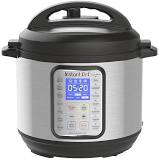 Food Network had a recipe for a Tex-Mex beef stew that was easy and tasty, and ready quickly -thanks to the Instant Pot. Though pressure-cooking certainly isn’t new, the Instant Pot has assisted in its comeback, and the pot’s safety mechanisms have assuaged people’s fears of exploding pot lids! So if Santa didn’t bring you any fun toys for Christmas, you might consider this appliance for your collection.
Food Network had a recipe for a Tex-Mex beef stew that was easy and tasty, and ready quickly -thanks to the Instant Pot. Though pressure-cooking certainly isn’t new, the Instant Pot has assisted in its comeback, and the pot’s safety mechanisms have assuaged people’s fears of exploding pot lids! So if Santa didn’t bring you any fun toys for Christmas, you might consider this appliance for your collection.
We’ll meet again on Friday, January 26 at 11 AM in the Fireplace Room. We have two titles this month, both focusing on plant-based diets: The VB6 Cookbook by Mark Bittman; and/or The Oh She Glows Cookbook by blogger Angela Liddon. Copies are available at the main desk.
A happy, healthy New Year to all!





